Dry soil, steep slopes, or awkward corners often go overlooked in landscaping plans—but they’re actually ideal spots for a rock garden. With the growing demand for low-maintenance and drought-resistant outdoor spaces, these clever installations are making a strong comeback in modern yards. They offer texture, structure, and year-round interest, all while requiring far less upkeep than traditional lawns or flower beds. From Zen-inspired layouts to naturalistic boulder groupings, there’s a style suited for every climate and skill level. Keep reading for thoughtfully selected rock garden ideas that make the most of tough terrain while delivering serious curb appeal and character.
Dry Creek Bed with Mixed River Rocks
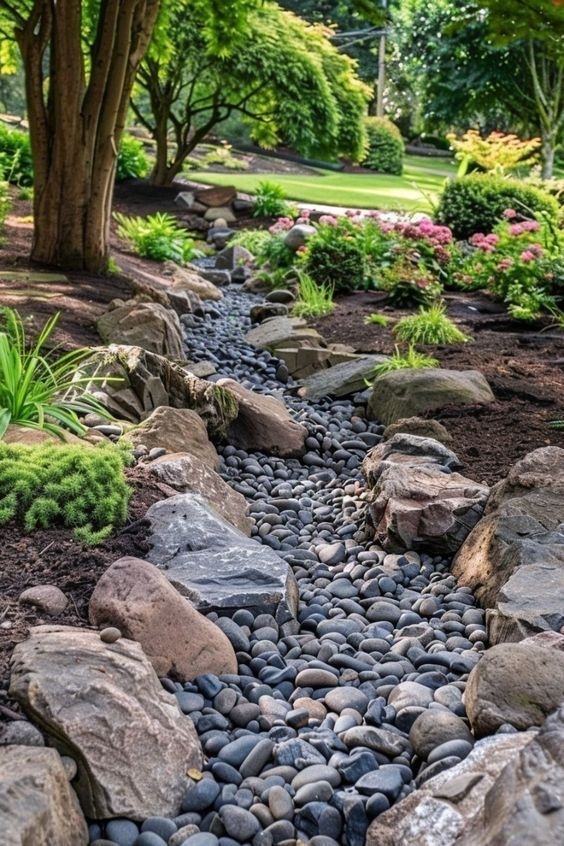
Strategically channeling rainwater runoff while enhancing visual texture, dry creek beds offer practical beauty. When filled with mixed river rocks—ranging from smooth pebbles to mid-sized cobbles—they mimic the natural course of a seasonal stream. Their functionality as drainage solutions is especially valuable for sloped landscapes or areas prone to water pooling. Contrasting rock shades and varied sizes break monotony and help guide the eye across your yard. Interspersing drought-resistant plants like sedum or blue fescue alongside the edges softens the structure and introduces seasonal color. For added detail, use boulders at curves to imitate natural erosion points. This feature works best with a slight gradient and properly graded soil beneath landscape fabric to prevent sinking or weed growth. Crushed gravel beneath the stones aids water flow and keeps them stable during heavy rainfall. Gardeners can integrate solar path lights for evening charm or lay stepping stones along the dry bed to invite movement across the space. Function meets design in this low-maintenance feature that withstands shifting weather and aging beautifully over time. Whether situated in a backyard corner or front yard slope, this visually engaging and eco-friendly element easily becomes a defining aspect of any xeriscape plan.
Succulent-Filled Gabion Walls
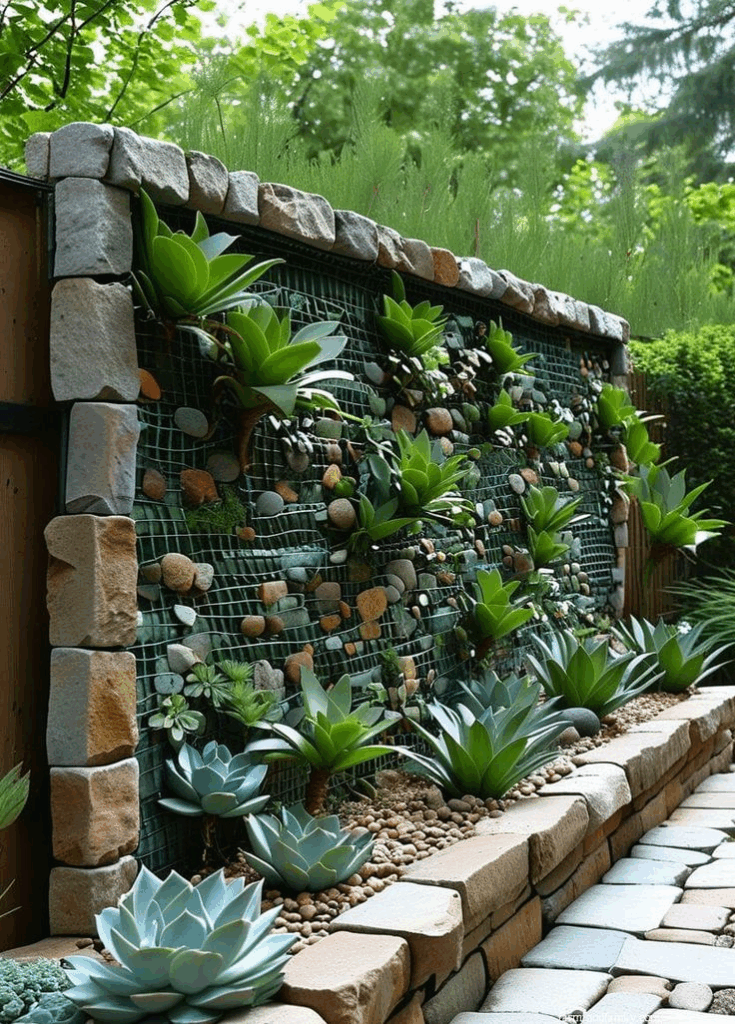
Merging structural support with botanical charm, gabion walls filled with succulents offer a creative and low-maintenance vertical gardening solution. Constructed from galvanized steel mesh baskets, these walls are typically filled with angular rocks or stones. To elevate their visual appeal and functionality, planters or open gaps between stones can be filled with soil pockets, allowing hardy succulents like echeveria, crassula, and sedum to thrive. These plants naturally withstand heat and drought, making them ideal for rock-based installations. When placed at eye level or used to define patio boundaries, gabion walls become interactive design features. Their porous nature allows for water drainage, reducing erosion and minimizing root rot risks. Mixing stone colors and shapes inside the cages adds visual intrigue, while the greenery introduces texture and soft contrast. For a modern rustic twist, blend slate, quartzite, or lava rock with trailing succulents for cascading effects. Positioning the wall to catch afternoon sun ensures optimal light exposure, promoting vibrant leaf tones and healthy growth. This idea is especially useful in small gardens needing vertical interest or erosion-prone hillsides that demand structural reinforcement. Succulent-filled gabion walls stand out as functional sculpture—tough, artistic, and surprisingly sustainable.
Zen-Inspired Gravel Patterns
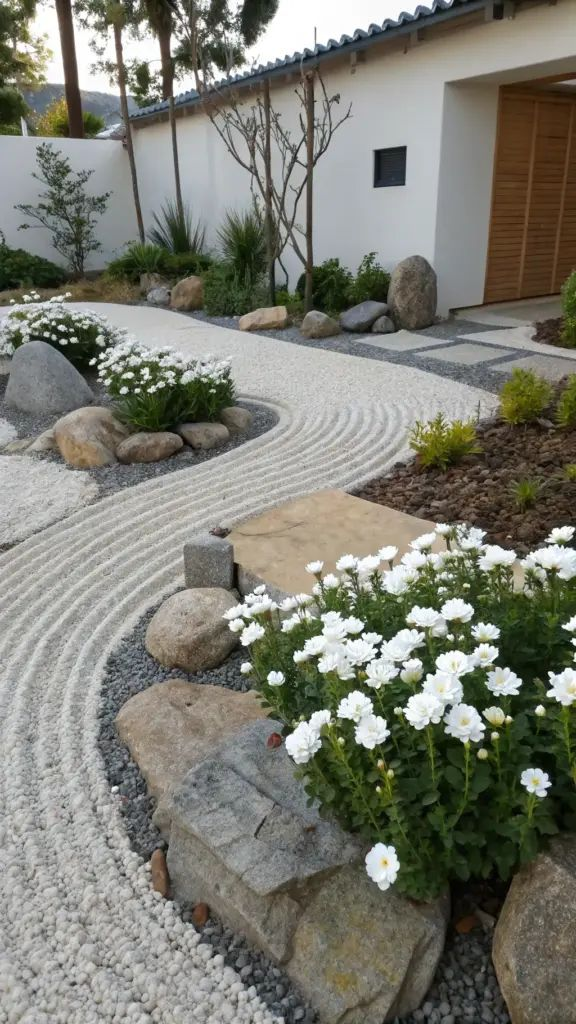
Blending visual harmony with meditative simplicity, raked gravel patterns found in Zen gardens offer both aesthetic impact and therapeutic value. Typically composed of crushed granite or white gravel, these dry landscapes emphasize balance and minimalism. Raking concentric circles, spirals, or parallel lines around strategically placed boulders simulates rippling water around islands—rooted in traditional Japanese symbolism. The process of raking itself encourages mindfulness, making this an excellent feature for those seeking outdoor tranquility. To maintain clean lines and structure, the gravel bed should be edged with timber, metal, or natural stone to prevent spillage. Opting for gravel with angular grains ensures patterns hold longer and resist wind displacement. Plantings are intentionally sparse—consider dwarf pines, moss patches, or a single, pruned Japanese maple to retain the calm atmosphere. Because this garden style avoids bright flowers and clutter, it complements modern homes and shaded courtyards alike. Illumination from warm LED ground lights adds a peaceful glow in the evening without disturbing the scene’s serenity. Beyond its peaceful function, this gravel feature requires little water or care, making it an ideal solution for homeowners prioritizing sustainability and spiritual ambiance. It proves that restraint in design often results in the most lasting impressions
Rock Spiral Herb Garden
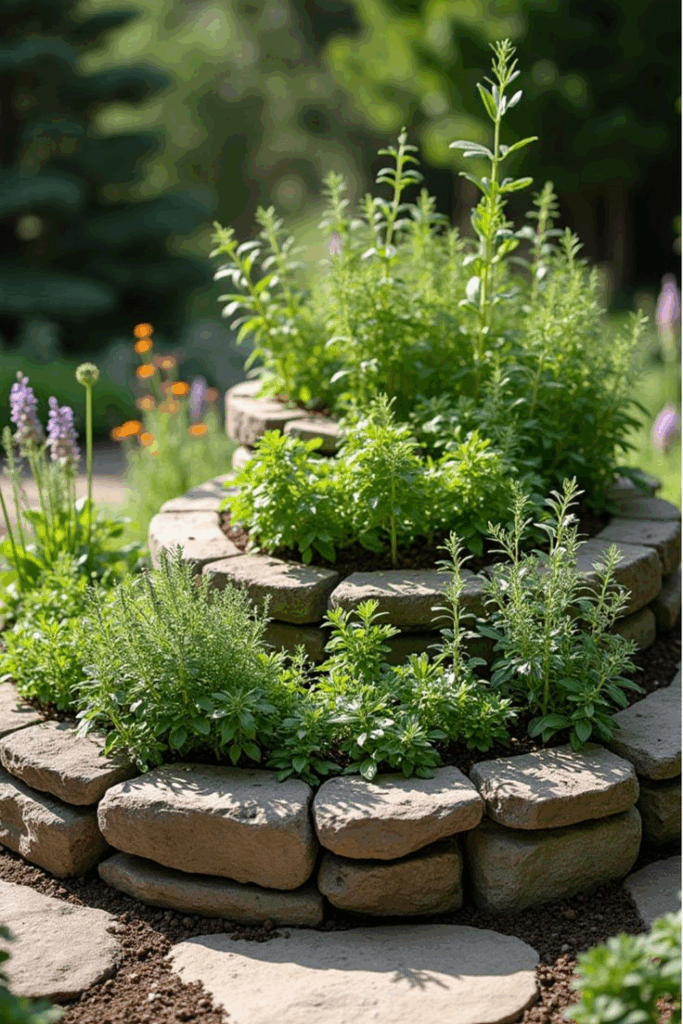
Utilizing vertical space and natural heat retention, a rock spiral herb garden offers both form and functionality for culinary enthusiasts and garden lovers. Crafted by stacking rocks in a circular, upward-tapering formation, the spiral design creates distinct microclimates—warmer at the top, cooler at the bottom—allowing diverse herbs to thrive. Mediterranean varieties like rosemary and thyme flourish near the top where drainage is quickest, while moisture-loving herbs such as mint and parsley fit better near the base. This configuration maximizes sun exposure and water distribution, making it efficient even in compact yards. Flat stones or bricks can be used to build the spiral, with gaps filled with well-draining soil. Integrating crushed gravel between the rocks supports drainage while deterring pests. This raised garden bed reduces the need for kneeling, appealing to gardeners with mobility concerns. For added visual cohesion, select stones that match or contrast with existing landscape elements. Seasonal replanting or edible flowers can refresh its appearance annually. Functional, beautiful, and environmentally thoughtful, this space-saving design enriches both your kitchen and garden landscape. The rock spiral becomes a conversation piece as well as a practical tool, blending architectural interest with fragrant, fresh harvests steps away from your door.
Mosaic Pebble Pathways
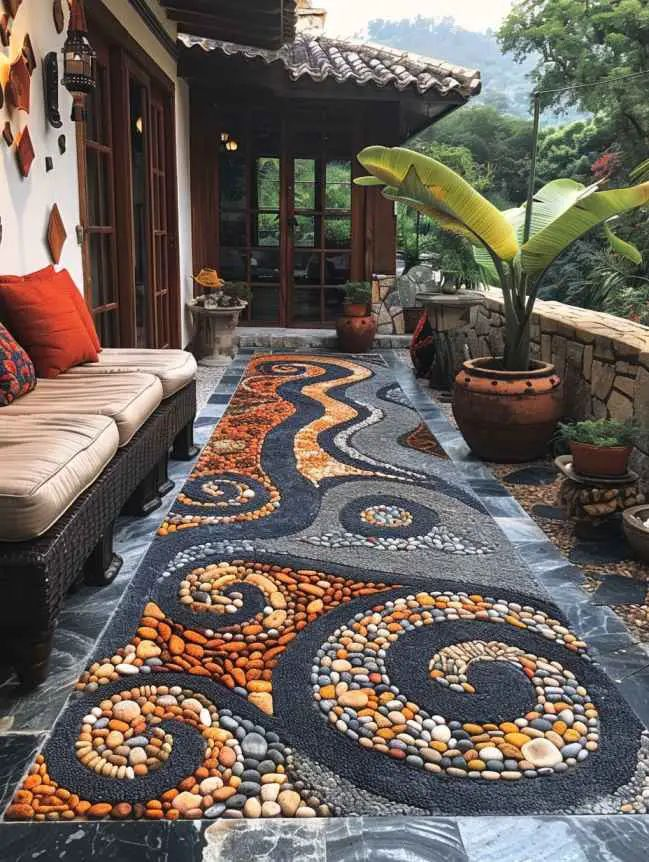
Mosaic pebble pathways inject artistry into the landscape while offering durable, non-slip surfaces ideal for high-traffic zones. These paths typically feature intricate patterns—floral motifs, mandalas, or geometric designs—crafted by embedding small, colored pebbles into a mortar base. Beyond aesthetics, they guide movement and visually connect different zones within a garden. The tactile contrast of polished versus rough stones adds sensory interest underfoot. Materials such as river pebbles, tumbled glass, and even broken tile fragments can be arranged to form custom patterns. For longevity, the base should be excavated and layered with compacted gravel and sand before the mortar and design layer is applied. This ensures proper drainage and prevents cracking. Mosaic pebble paths pair beautifully with adjacent flower beds, water features, or rock gardens, providing both cohesion and drama. In shaded areas, lighter stones brighten the space, while darker pebbles create striking contrast in sunlit settings. Sealants may be used to enhance color vibrancy and prolong durability. Whether forming a central walkway or meandering around sculptural plantings, these pathways turn everyday transitions into visual journeys. They’re a testament to the way hardscaping can reflect personal creativity while holding up to nature’s elements over the years.
Alpine Rock Garden with Dwarf Conifers
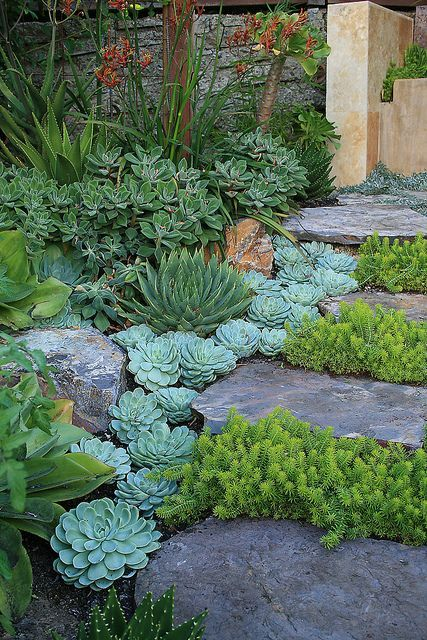
Drawing inspiration from mountain terrains, alpine rock gardens with dwarf conifers deliver year-round structure and texture, even in small plots. These gardens emulate high-elevation conditions by using rocky outcrops, gravel mulch, and compact plantings that resist wind and drought. Dwarf conifers like mugo pine, dwarf spruce, or slow-growing junipers thrive in these conditions and provide evergreen interest through all seasons. When paired with alpine perennials—think saxifrages, gentians, and miniature hostas—the space balances toughness with bursts of seasonal bloom. Well-draining soil is essential, typically amended with sand or grit to mimic the sharp drainage of mountain slopes. Boulders or natural rock slabs should be embedded partly into the ground for realism and visual anchor. Positioning the taller conifers toward the center or backdrop adds height variation while maintaining scale. Mulching with granite chips reduces weeds and reinforces the alpine aesthetic. This low-maintenance concept appeals to gardeners in colder regions or those seeking a structured yet naturalistic layout. Whether featured on a slope or flat terrain, the design creates a serene, sculptural space that changes subtly with the seasons. Alpine rock gardens with dwarf conifers serve as a sanctuary for small pollinators and a refreshing escape from lush, water-intensive plantings.
Rock Garden with Integrated Seating
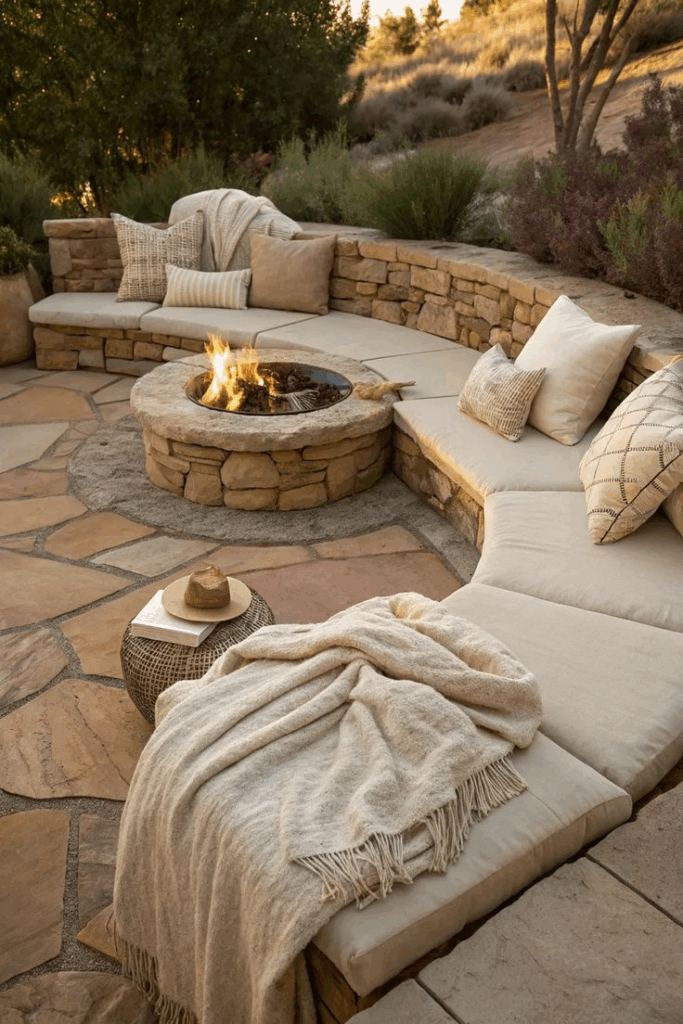
Merging comfort with natural beauty, a rock garden that includes integrated seating offers a place to pause and enjoy the surrounding landscape. Built-in stone benches, boulder stools, or low rock walls serve as resting spots that harmonize with the garden’s materials. This approach eliminates the need for added furniture and preserves the organic aesthetic. Flat-topped stones or stacked flagstone slabs are ideal for crafting sturdy, ergonomic seating that ages well outdoors. These structures often become focal points when positioned near water features, floral pockets, or shaded corners. To ensure comfort, the top surfaces should be smooth and slightly angled for drainage. Surrounding the seating with ornamental grasses, ground covers like creeping thyme, or cushion moss can soften edges and enhance usability. LED lighting tucked into crevices adds evening ambiance without disrupting the natural feel. This idea suits both small urban spaces and expansive yards, offering a retreat within the landscape itself. The use of native stone helps tie the feature into its environment, reducing visual clutter and maintenance. Integrated rock seating transforms the garden into a destination, not just a visual accent. It’s a practical yet visually grounded solution for outdoor living and mindful relaxation.
Color-Themed Rock Arrangements
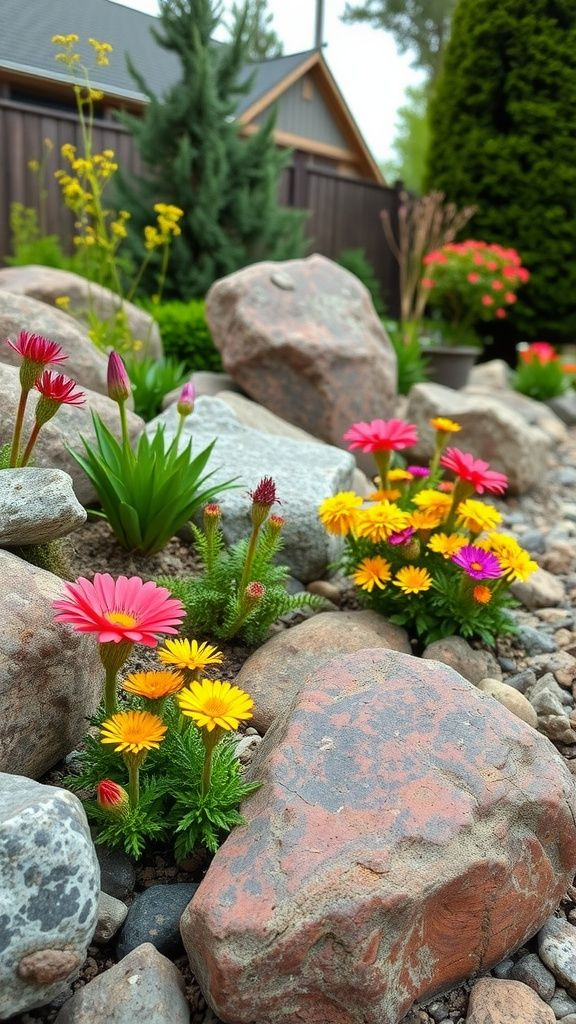
Designing a rock garden around a specific color palette adds intentionality and visual unity to the landscape. Using stones in shades of slate gray, warm tan, icy white, or volcanic black creates a curated look that resonates with nearby structures or planting schemes. Whether working with natural quartz, river rock, basalt, or red lava stone, color coordination provides rhythm and distinction. Grouping similarly hued stones by size—large boulders as anchors and smaller pebbles as filler—ensures balance and hierarchy. These themes can complement monochromatic planting or be used to contrast vibrant foliage for dramatic impact. For example, pairing silver-toned rocks with blue grasses or purple sage enhances their cool undertones. Sunlight and water alter the appearance of rock color throughout the day, offering subtle variation without sacrificing cohesion. It’s crucial to choose rock materials that maintain hue over time and resist staining. Weed-blocking fabric and proper drainage layers ensure longevity and keep the color composition crisp. This technique is especially effective in contemporary landscapes or minimalist designs where cohesion matters more than plant variety. A color-themed rock arrangement elevates the entire garden’s style while keeping the layout tidy and manageable through all seasons.
Tiered Rock Waterfall Feature
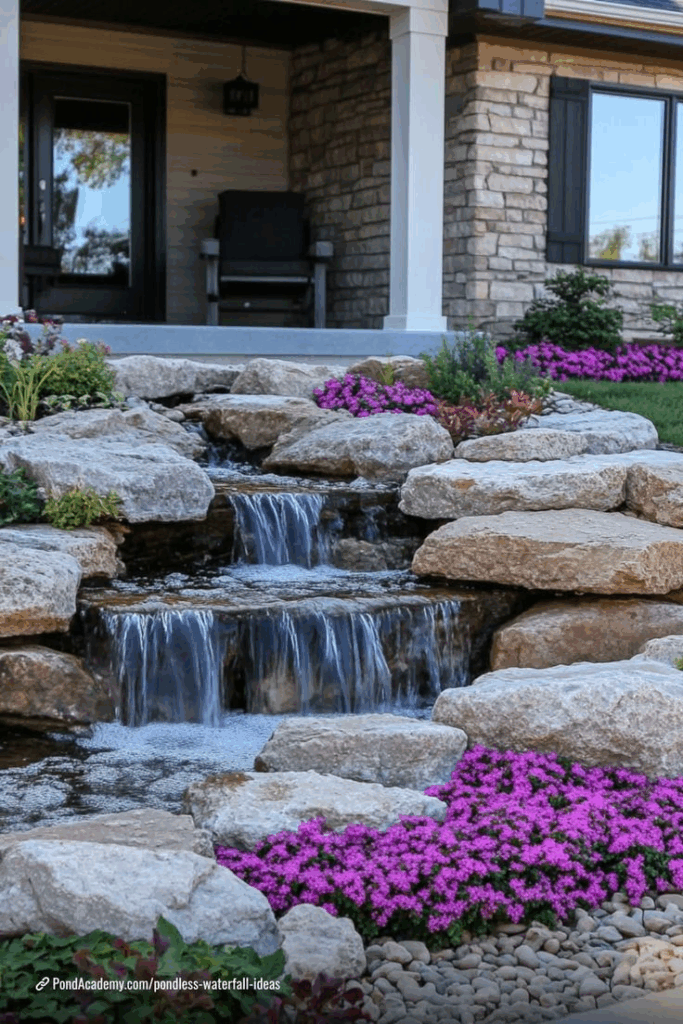
Simulating the look and sound of a natural mountain cascade, tiered rock waterfall features bring dynamic energy to static garden spaces. Constructed using stacked rocks and boulders of varying sizes, this multi-level design encourages water to gently flow from one basin to the next. A concealed submersible pump circulates water continuously, creating soothing white noise and drawing in birds and pollinators. Selecting weathered granite or flat sandstone ensures each tier offers stability and visual interest. Placement near patios or seating areas enhances its sensory presence. To blend the structure with its environment, use native rocks and frame the base with moisture-loving plants like hosta, marsh marigold, or horsetail reed. Consider lining the basin with black pond liner and adding decorative river pebbles for a finished appearance. LED underwater lights amplify the cascading effect after dark. Proper grading and a hidden reservoir are essential to avoid leaks and ensure smooth recirculation. This feature not only enhances curb appeal but also contributes to microclimate cooling during hot months. Maintenance involves periodic pump cleaning and topping off water lost to evaporation. Tiered rock waterfalls enrich any garden with texture, sound, and motion—transforming a simple slope into a natural spectacle.
Rock Garden Border with Ornamental Grasses
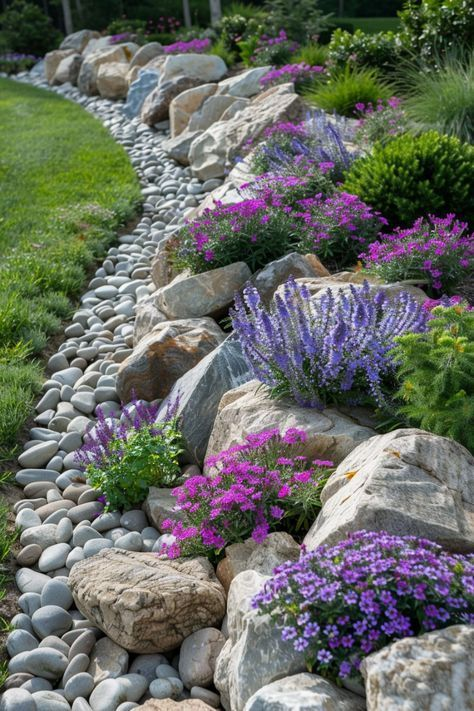
Framing a rock garden with ornamental grasses introduces softness, movement, and seasonal variety without overwhelming the hardscape. Species like blue fescue, Mexican feather grass, and Japanese forest grass thrive in well-drained soils and pair naturally with stone textures. Their fine blades and gentle swaying contrast beautifully against rigid rocks and gravel beds. Placing grasses along the garden’s outer edges establishes boundaries while maintaining an organic flow. Taller varieties can create windbreaks or visual screens, while low mounding types offer ground-hugging accents. Their root systems help anchor soil, making them ideal for erosion control around rock features. To enhance visual layering, alternate grass heights and shades—mixing chartreuse, burgundy, and steel-blue hues for added depth. These low-maintenance plants rarely require fertilization and often self-clean with seasonal trimming. Grasses remain attractive even during dormancy, providing winter structure when many flowers have faded. When paired with upright rocks or boulders, the result is a balanced interplay of lines and forms. This approach works well in modern, naturalistic, or prairie-style gardens where minimal water use is a priority. Borders made with ornamental grasses offer a living frame for your rockwork, blending beauty with ecological benefit.
Fire Pit Surrounded by Rock Seating
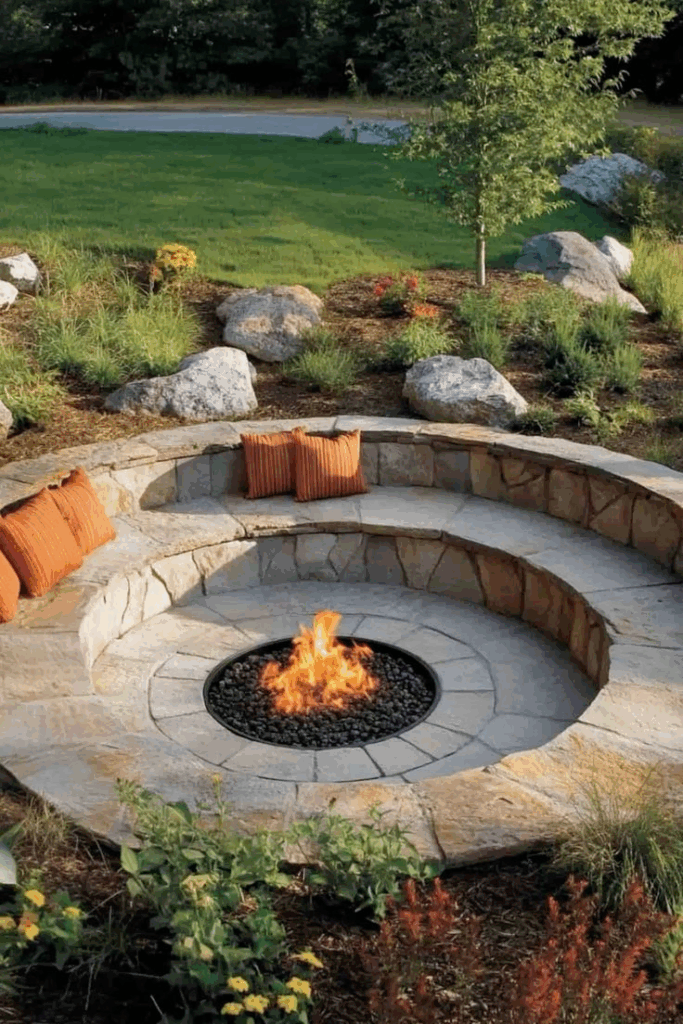
Creating a fire pit within a rock garden merges functionality with rustic design, offering a year-round gathering space that complements natural materials. A sunken or raised fire basin made from heat-resistant stone becomes the central feature, often encircled by seating built from boulders or stacked stone benches. This layout not only grounds the space visually but also withstands outdoor elements far better than traditional patio furniture. Fire-safe gravel or decomposed granite around the pit improves drainage and reduces fire hazards. To add structure, position taller rocks as windbreaks and use low, flat stones as footrests or side tables. The seating should be spaced comfortably, with airflow and safety zones in mind. Adding small uplights behind the seating or within crevices enhances ambiance after dusk. This setup suits open yards, patios, or sloped areas where retaining walls can double as seating. Consider integrating native shrubs or groundcovers nearby to soften the edges and blend the feature into the landscape. It’s a gathering point that encourages social interaction while preserving the organic character of your garden. Durable, visually compelling, and elemental in appeal, this fire pit concept turns a rock garden into a versatile living area that draws guests well beyond summer.
Rock Garden with LED Uplighting
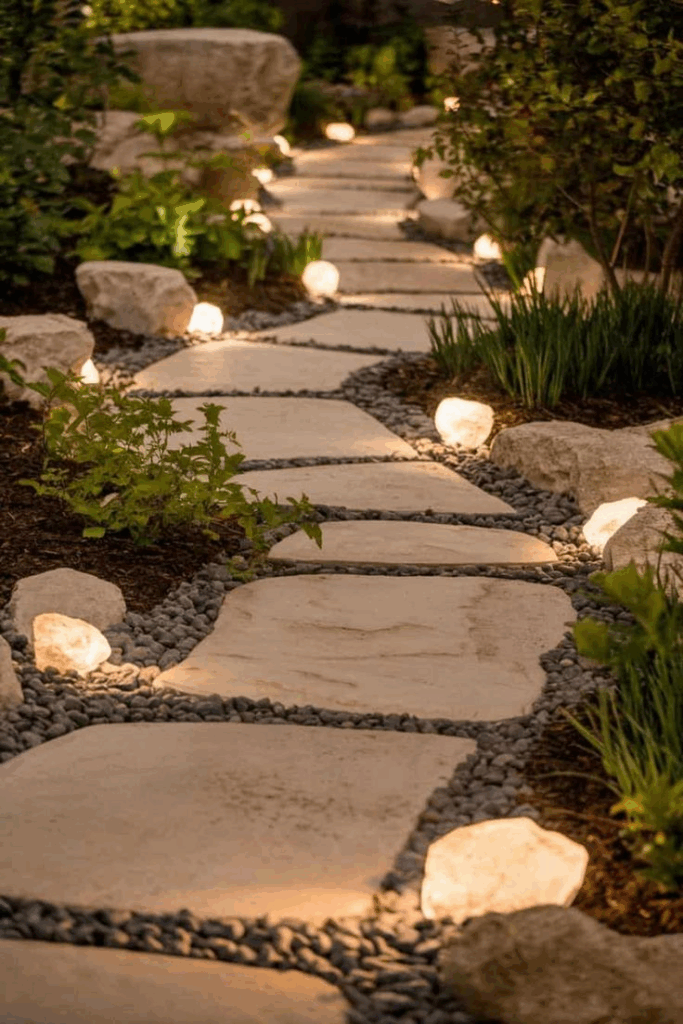
Strategically placed LED uplighting adds drama and depth to a rock garden, transforming it into a nighttime focal point. By aiming light from below toward sculptural boulders, tiered arrangements, or standout plants, shadows and textures are amplified for theatrical effect. This technique emphasizes the garden’s contours, guiding the eye even after sunset. Weatherproof LED fixtures are energy-efficient and come in warm or cool tones to match the overall landscape palette. Positioning lights beneath rock overhangs or within gravel beds keeps them discreet during the day while creating a glowing ambiance at night. Illuminating contrasting textures—like rough granite next to glossy foliage—further enhances visual interest. It’s wise to use solar-powered or low-voltage systems for safety and sustainability. Lighting should always be angled away from viewers’ eyes and shielded to prevent glare. Timers or smart controllers simplify use, syncing the illumination with outdoor schedules. When paired with reflective surfaces like polished stone or water elements, the effect becomes even more enchanting. This lighting upgrade is ideal for patios, entryways, or viewing areas that benefit from extended usability. Beyond aesthetics, it also increases nighttime safety, making pathways and steps more visible. It’s a subtle yet striking way to let your rock garden shine after dark.
Cactus and Rock Desert Landscape
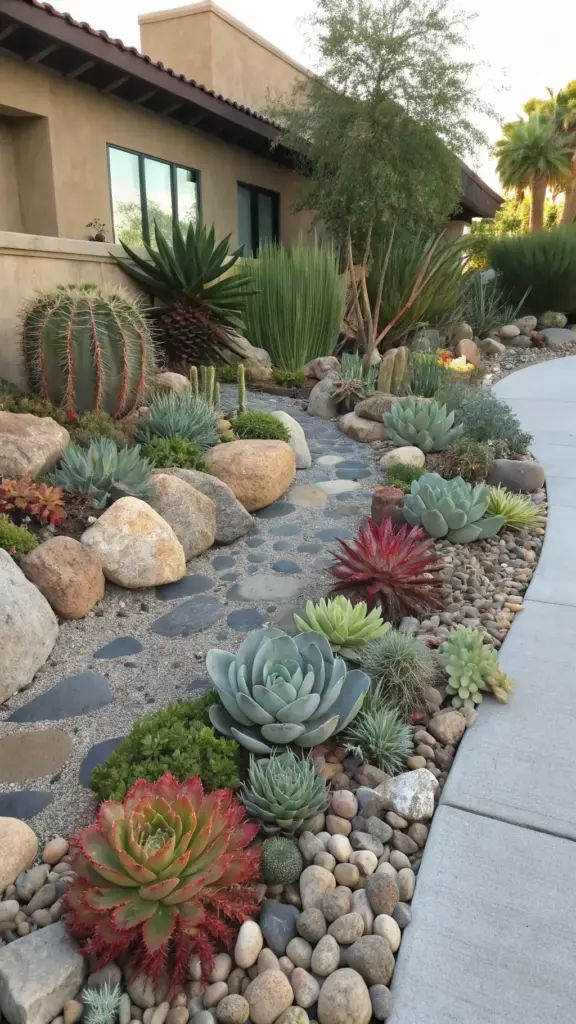
Combining hardy succulents with sun-drenched stonework, cactus-based desert landscapes bring architectural intrigue and ultra-low maintenance to arid zones. This style relies on well-draining soil, gravel mulch, and a thoughtful mix of textures. Cacti—such as golden barrel, prickly pear, and saguaro—offer sculptural forms and seasonal blooms that stand out against crushed granite or sandstone chips. Boulders and rock groupings provide contrast and serve as microclimates, helping retain heat and protect roots. Color plays a crucial role—red lava rock adds warmth, while pale gravel brightens the space. This design thrives in regions with minimal rainfall and looks natural in southwestern or drought-prone settings. For visual balance, alternate tall columnar cacti with low-growing agaves or aloes. Between plantings, tuck in decorative rocks, fossil slabs, or petrified wood for geological variety. Pathways lined with smooth pebbles invite exploration without disrupting the minimalist vibe. To keep the space visually clean, regular grooming and weed control are essential. Drip irrigation or soaker hoses hidden beneath the mulch help young plants establish without oversaturating the soil. A cactus and rock desert landscape isn’t just about water conservation—it’s a celebration of sculpted simplicity and natural resilience in harsh conditions.
Rock Garden with Reflective Mirror Accents
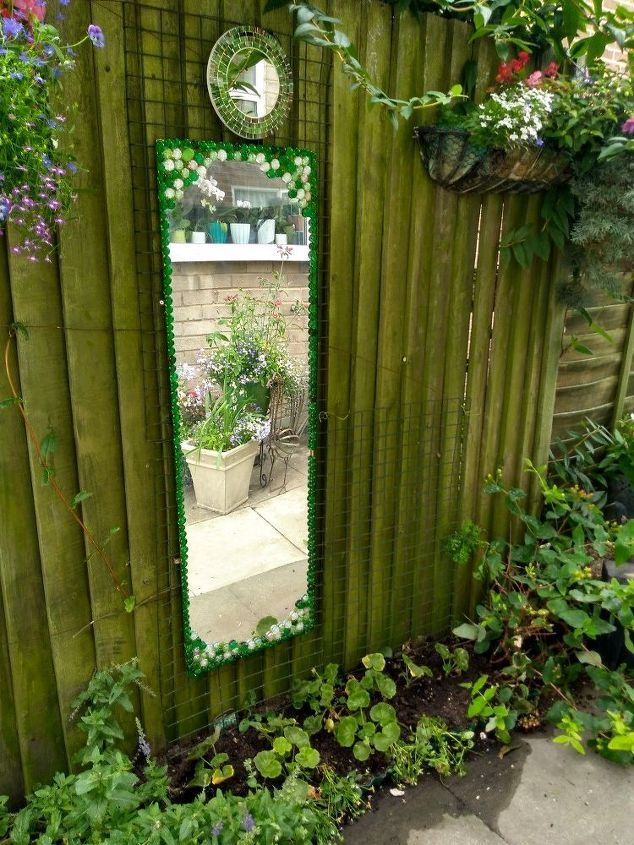
Amplifying space and light, mirrors integrated into rock gardens offer a striking visual illusion, especially in compact areas. Carefully placed reflective panels or mirrored tiles tucked among stones or behind plantings can make the space appear larger and more dynamic. These accents work particularly well in shaded corners, where light is limited, or enclosed gardens that benefit from depth enhancement. Framing the mirrors with weather-resistant materials like stainless steel or reclaimed wood helps them withstand outdoor conditions while blending with natural elements. Mirror size and placement matter—angled reflections should highlight textures, not expose unwanted areas like utility spaces or fences. Surrounding the reflective surfaces with gravel mulch or flat river stones prevents splashback and water spots during rainfall. For safety, always use shatterproof or acrylic mirror alternatives outdoors. In gardens with vertical rock walls or gabion structures, embedding mirror strips between rock layers produces subtle, artistic reveals as visitors move through the space. This approach is especially effective in modern, artistic, or courtyard-style landscapes where design impact must come from creative spatial manipulation. By combining rigid stone with fluid reflection, this idea adds both contrast and surprise—inviting viewers to see their garden from new perspectives.
Seasonal Rock Garden Displays
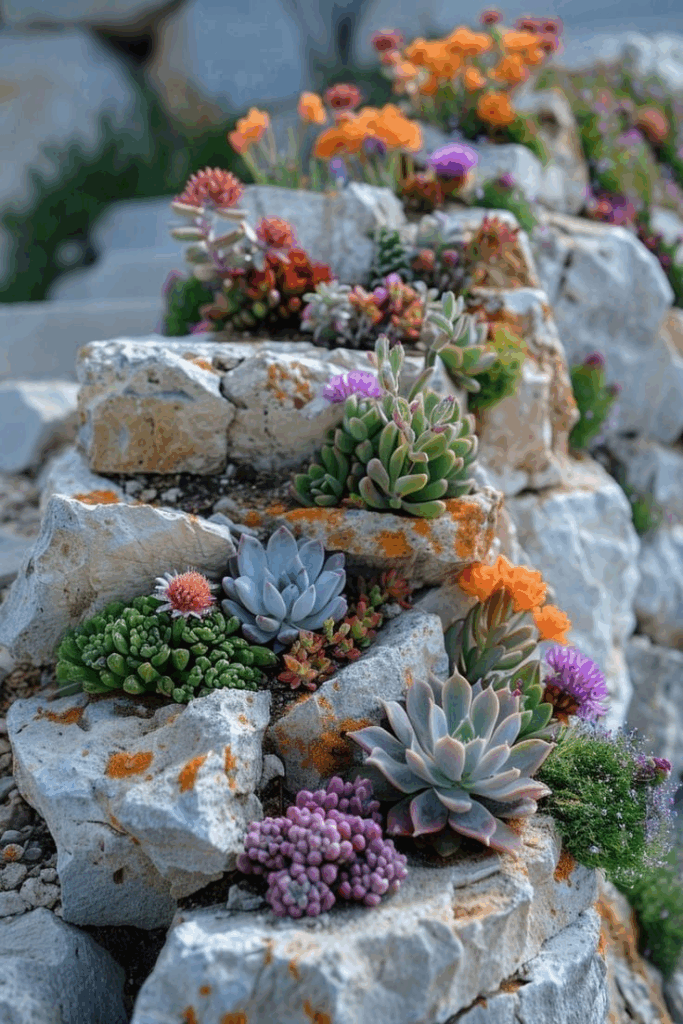
Designing a rock garden that evolves with the seasons keeps the landscape visually fresh and contextually relevant year-round. By coordinating plant choices and decorative accents to match seasonal shifts, the garden transforms without altering its foundational rockwork. Spring may feature low-growing bulbs like grape hyacinth or miniature daffodils peeking between stones, while summer ushers in flowering groundcovers such as ice plant or creeping phlox. Autumn interest can be introduced with ornamental kale, red sedum, or decorative gourds nestled in gravel beds. Winter doesn’t need to be barren—strategically placed evergreen mosses, conifers, and frosted quartz pebbles provide texture and color when foliage fades. Seasonal rotation doesn’t require a complete overhaul; portable planters or swappable decorative elements make adjustments simple. Repeating elements like ceramic mushrooms, small lanterns, or natural wood sculptures enhance the theme without disrupting the overall balance. It’s helpful to maintain an anchor—such as a central boulder or dry river feature—that remains constant through all changes. This approach keeps the space engaging and photographable for every time of year, especially for those who enjoy celebrating outdoor shifts. A thoughtfully curated seasonal display ensures your rock garden is never static and always attuned to nature’s rhythms.
